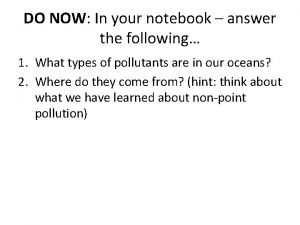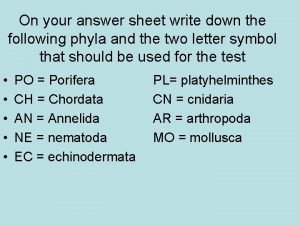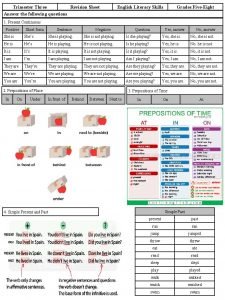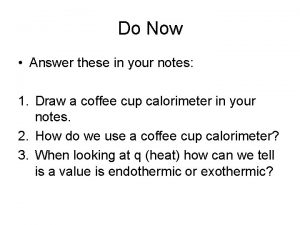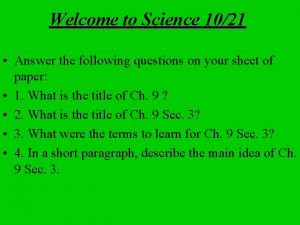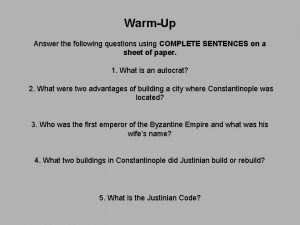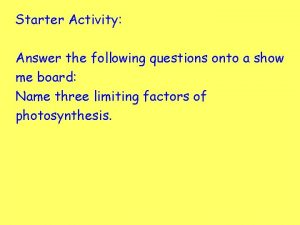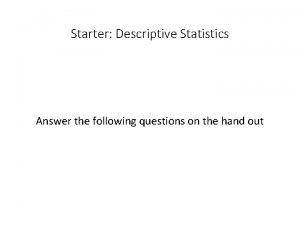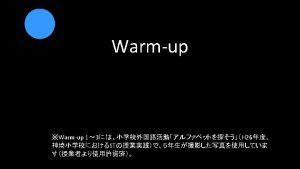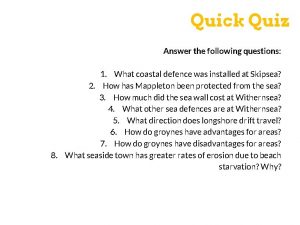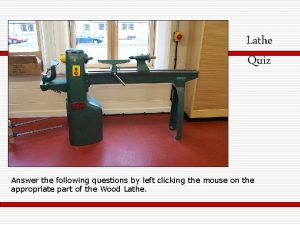Do Now Starter Quiz Answer the following questions














- Slides: 14

Do Now – Starter Quiz Answer the following questions, to see how much you can remember about enzymes 1. What are enzymes made of? 2. What do enzymes do? 3. What is the name of the substance that an enzyme acts on? 4. What is the name of the part of an enzyme that has a specific shape? 5. What two factors are enzymes most affected by? 6. What term do we use to say when an enzyme has been ‘disrupted’ and so doesn’t work anymore?

Introduction to Enzymes Learning objective • To recap GCSE learning of enzymes Success Criteria

Introduction to Enzymes • Enzymes are globular proteins with a specific tertiary structure • The action of enzymes can either be inside a cell or outside a cell • What is the term given to action inside the cell? Intracellular • What is the term given to action outside the cell? Extracellular • Enzymes are known as biological catalysts that speed up (catalyse) metabolic reactions • Q: How do enzymes speed up reactions? • They lower the activation energy, therefore increasing the rate of the reaction

GCSE Enzymes Recap • Enzymes are highly specific biological molecules Q: What is the name of the specific part of the enzyme? Active site • Enzymes are very sensitive to changes in both temperature and p. H Q: What is the term used to describe what happens when enzymes are exposed to high temperature? Denature • Enzymes are highly specific molecules, and only specific enzymes will catalyse specific reactions Substrate molecule in the ACTIVE SITE Enzyme molecule


GCSE Enzymes Recap – describing the lock and key model Use this diagram to see if you can remember how the lock and key model of enzyme action works

The Lock And Key Model In an enzyme - catalysed reaction, the enzyme binds to the substrate to form an enzyme-substrate complex. Enzyme molecule S An enzyme - substrate complex forms Products diffuse away from the active site A reaction occurs forming an enzyme - product complex The lock & key model proposes that the substrate binds to the active site which it fits exactly, like a key in a lock


Lock and Key Definition • The lock and key theory states that an enzyme will only catalyse a reaction if the substrate has a complementary shape to its active site. • An enzyme-substrate complex will only form if the substrate fits exactly into the active site.

The Induced Fit Model • This model takes into account the fact that proteins (enzymes) have some three-dimensional flexibility. Substrate binds to the enzyme It states that the active site SUBSTRATE shape of active sites are not exactly Binding of the substrate induces the enzyme to change complementary, shape such that there is an but change shape in exact fit once the substrate the presence of has bound a specific substrate to become Enzyme Molecule According to this model, reactions can complementary. only take place AFTER induced fit has occurred


TASK • Using p. 105 -106 in the textbook, create a comparison table for the lock and key and induced fit hypothesis Lock and Key Model Induced Fit Hypothesis

To finish… One form of pulmonary disease develops because enzymes are released by phagocytes entering the alveoli of the lungs. This enzyme action can break down the elastin in the lining of the bronchioles and the alveoli. Use the example of elastin to explain the induced-fit hypothesis of enzyme action

HOMEWORK • Read through the method for your chromatography PAG
 Now answer the following questions in your notebook
Now answer the following questions in your notebook In your notebook answer the question
In your notebook answer the question In your notebook, answer the following questions.
In your notebook, answer the following questions. Now answer the
Now answer the Passive transport vs active transport venn diagram
Passive transport vs active transport venn diagram In your answer sheet, answer the following questions
In your answer sheet, answer the following questions Trimester fill in worksheet answers
Trimester fill in worksheet answers Now answer the questions
Now answer the questions Slide to answer
Slide to answer Coffee cup calorimeter
Coffee cup calorimeter Now i see it now you don't
Now i see it now you don't Answer the questions in pairs
Answer the questions in pairs Answer the following questions science
Answer the following questions science Answer the following questions in complete sentences.
Answer the following questions in complete sentences. Use the graph at the right to answer the question below
Use the graph at the right to answer the question below

